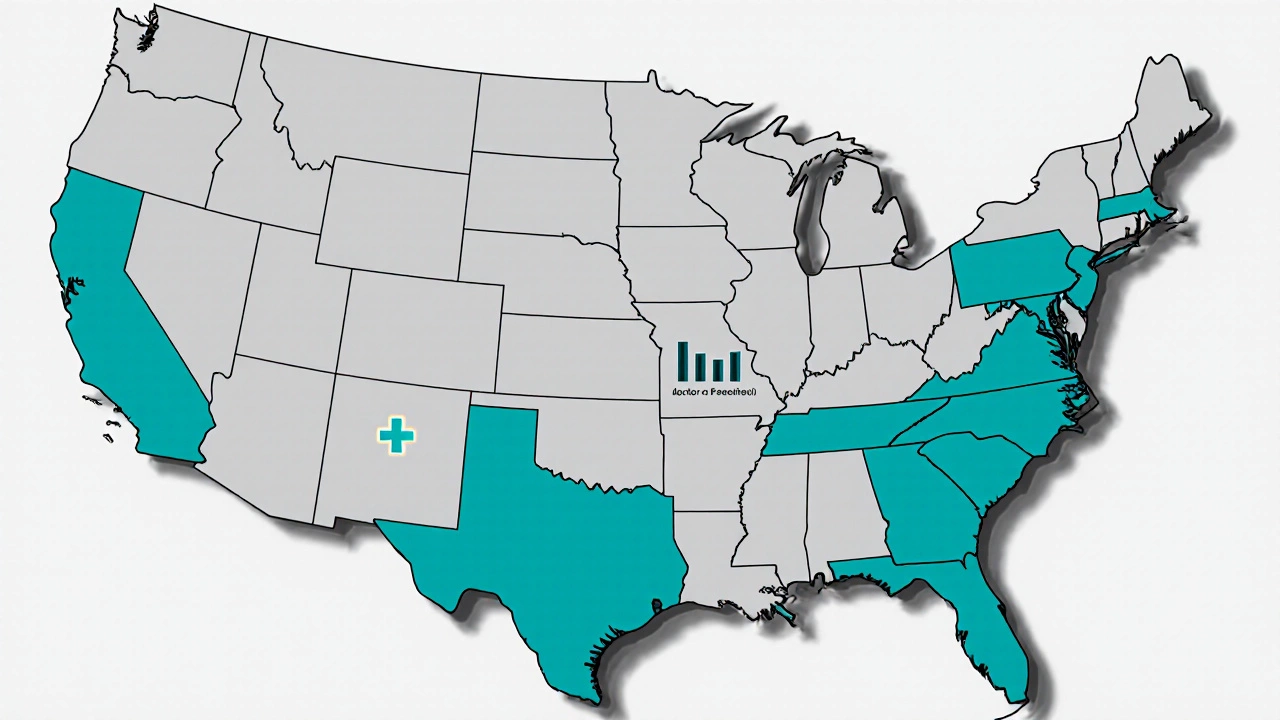US Medical Tourism State Selector
Find Your Best US State for Medical Treatment
Select your medical specialty and budget to see which top US states match your needs.
Based on your selection:
Specialty:
Budget:
Key factors to consider:
- Doctor-to-patient ratio
- JCI-accredited hospitals
- Language support
- International patient services
When you think about traveling abroad for treatment, the first question that pops up is: best doctors. In the United States, the quality of physicians varies a lot from state to state, and that variation matters a lot for medical tourists who want world‑class care without the hassle of language barriers or visa issues. Below we break down the key factors that determine a state’s doctor quality, rank the top performers, and give you a practical checklist for picking the right destination.
Key Takeaways
- Massachusetts, Minnesota, and California consistently lead in doctor quality and patient outcomes.
- Doctor‑to‑patient ratio, hospital accreditation, and specialty concentration are the three metrics to watch.
- Medical tourism facilitators often favor states with international patient services and transparent pricing.
- Check accreditation bodies like Joint Commission International (JCI) and health‑rating platforms such as U.S. News & World Report.
- Consider visa assistance, travel logistics, and post‑treatment support when choosing a state.
What Makes a Doctor "Best" in a State?
To answer the headline, we need a clear definition of "best". In the context of medical tourism, a "best" doctor is one who scores high on three overlapping criteria:
- Clinical Excellence: measurable outcomes (mortality, complication rates) and peer‑reviewed recognitions.
- Accessibility: reasonable wait times, multilingual staff, and dedicated international patient offices.
- Affordability & Transparency: clear cost structures, bundled packages, and insurance compatibility.
These criteria line up with the data published by the American Hospital Association (a national organization that tracks hospital performance, staffing, and patient safety metrics) and the annual U.S. News & World Report (the leading ranking system for hospitals and physicians in the United States)
.Data Sources You Can Trust
We relied on a mix of public datasets and specialized platforms:
- CDC Hospital Compare: provides doctor‑to‑patient ratios and infection rates.
- Healthgrades: scores physicians on patient satisfaction and outcomes.
- Joint Commission International (JCI): accredits facilities that meet global safety standards.
- Accreditation Council for Continuing Medical Education (ACCME): tracks continuing education credits, a proxy for keeping doctors up‑to‑date.
When the numbers line up across these sources, you can be confident the state truly hosts top‑tier doctors.
Top 5 US States for Medical Tourism Doctors
Based on the three core criteria, these states rank highest for international patients seeking world‑class physicians.
| State | Doctor‑to‑Patient Ratio (per 1,000) | Top Hospital(s) (Accredited) | Specialty Strength | Average International Patient Cost (USD) |
|---|---|---|---|---|
| Massachusetts | 2.8 | Harvard Medical School Affiliated Hospitals (JCI) | Oncology, Cardiology | 30,000‑45,000 |
| Minnesota | 2.6 | Mayo Clinic (JCI) | Orthopedics, Neurosurgery | 25,000‑40,000 |
| California | 2.5 | UCSF Medical Center (JCI) | Cardiology, Transplant | 35,000‑55,000 |
| Texas | 2.4 | Texas Medical Center (JCI) | Cardiovascular, Diabetes Care | 20,000‑38,000 |
| Florida | 2.3 | Jackson Memorial Hospital (JCI) | Geriatrics, Cosmetic Surgery | 22,000‑36,000 |
Notice how the top three states also host the most internationally recognized hospitals. The doctor‑to‑patient ratio is a quick proxy: the lower the number, the more time a physician can spend per patient.

Spotlight on the Leaders
Below is a brief look at why these states dominate the rankings.
Massachusetts - The Academic Powerhouse
Massachusetts benefits from a dense cluster of elite research universities. Physicians at Harvard Medical School affiliated hospitals routinely publish in top journals, and the state’s Johns Hopkins Hospital (though based in Maryland, it collaborates closely with Massachusetts research institutions and attracts many patients from the state for specialized care) often serves as a referral hub for complex cases.
Minnesota - The Mayo Clinic Effect
The Mayo Clinic (a non‑profit medical group renowned for coordinated, patient‑centered care and consistently top‑ranked in multiple specialties) sets a gold standard for multidisciplinary teams. Its integrated electronic health record lets doctors collaborate across borders, easing the medical tourism experience.
California - Innovation Meets Diversity
Silicon Valley’s tech spill‑over fuels tele‑medicine and AI‑assisted diagnostics. California’s hospitals also offer extensive language services-critical for patients from Asia and Latin America.
How to Pick the Right State for Your Treatment
Even within top states, the right doctor for you depends on the condition, budget, and logistical preferences. Follow this checklist before you book your trip:
- Identify the specialty: Use Healthgrades or U.S. News to find the leading centers for your condition.
- Verify accreditation: Look for JCI or Commission on Cancer accreditation; they ensure international safety standards.
- Compare doctor‑to‑patient ratios: Lower ratios usually mean more personalized attention.
- Ask about international patient offices: These units handle visa paperwork, translation, and post‑op follow‑up.
- Get a transparent cost quote: Request a bundled package that includes surgery, hospital stay, medication, and a short recovery stay.
- Check travel logistics: Direct flights, proximity to the hospital, and availability of recovery accommodations matter.
Running through this list cuts down the guesswork and helps you avoid hidden fees or language gaps.
Common Pitfalls and How to Avoid Them
- Assuming "top hospital" = best doctor: A hospital may be famous, but individual physicians vary. Check the doctor’s board certifications and patient reviews.
- Ignoring visa requirements: Some states have specific medical‑tourist visa categories; coordinate with the hospital’s international office early.
- Overlooking post‑treatment care: Recovery can take weeks. Choose a state with reputable rehab centers and easy follow‑up tele‑consults.

Future Trends Shaping Doctor Quality in the US
By 2030, three trends will likely shift the landscape:
- AI‑driven diagnostics: States investing in AI research (California, Massachusetts) will see faster, more accurate diagnoses.
- Value‑based care models: Medicare’s shift to outcome‑based payments encourages hospitals to improve doctor performance metrics.
- Tele‑health expansion: More states will offer virtual pre‑op consultations, making it easier for international patients to connect with the right physician before traveling.
Keeping an eye on these developments helps you choose a state that will stay ahead of the curve.
Quick FAQ for Medical Tourists
Which US state offers the most affordable top‑level doctors?
Texas typically provides the lowest average cost for international patients while still hosting JCI‑accredited hospitals like the Texas Medical Center.
Do US hospitals help with visas?
Yes. Most top hospitals have an International Patient Services department that assists with B‑2 tourist visas or the newer M‑1 medical‑student visa, depending on the length of stay.
How can I verify a doctor’s credentials?
Check the physician’s board certification on the American Board of Medical Specialties website and cross‑reference patient outcomes on Healthgrades or U.S. News rankings.
Is travel insurance necessary for medical tourism?
Strongly recommended. Choose a plan that covers pre‑ and post‑procedure care, as well as potential complications during travel.
What language support is available?
Leading hospitals in California, New York, and Texas offer multilingual coordinators (Spanish, Mandarin, Hindi, Arabic) to guide patients throughout their stay.
Next Steps for Prospective Medical Tourists
1. Pick your target condition and shortlist the top three states from the table above.
2. Reach out to the International Patient Office of at least two hospitals to request a detailed cost proposal.
3. Compare the proposals using the checklist - focus on doctor credentials, JCI accreditation, and total out‑of‑pocket cost.
4. Secure your visa, arrange travel, and plan a short recovery stay near the hospital.
5. After treatment, schedule tele‑follow‑up appointments to monitor progress back home.
Following these steps puts you in the driver’s seat and maximizes the chances of a smooth, successful medical tourism experience.





